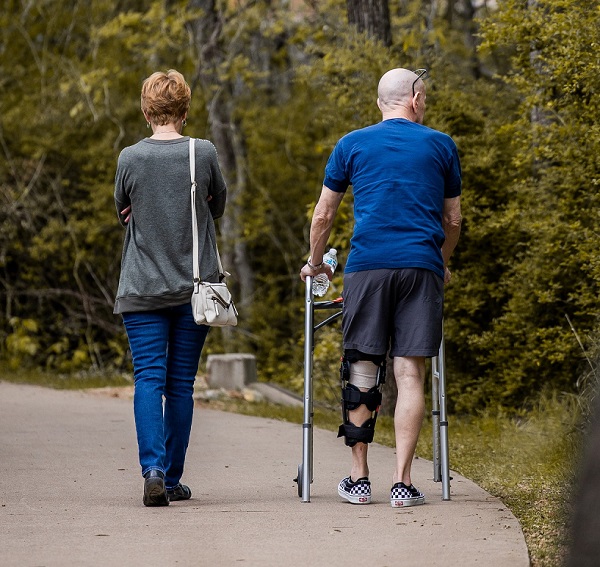Individuals diagnosed with osteoporosis are often prescribed lifestyle changes, along with medication. These include —
- Giving up smoking
- Ensuring adequate calcium and vitamin D intake [1,500mg per day of calcium, preferably through diet and/or supplements; 800-1,200IU [international units] of vitamin D, especially in adults aged 55+
- Limiting alcohol consumption
- Regular exercise
- Additional measures — avoid falls, or change room layouts, correct visual defects and take precautions with medications that may cause giddiness
- Hip padding may also be used for protection
- Though research data on the effectiveness of medications to treat men with osteoporosis are lacking, doctors prescribe bisphosphonates and calcitonin because, in theory, they should have the same good effects as in women
- While alendronate sodium is prescribed for use in certain men with osteoporosis, some clinicians recommend the use of testosterone [replacement] therapy in certain patients.
Note: A woman’s risk of hip fracture is equal to her combined risk of breast, uterine and ovarian cancer. Besides, the rate of hip fracture is 2-3 times higher in women than men; also, the one-year mortality rate following a hip fracture is nearly twice as high for men as for women.
Ayurveda:
According to Ayurveda, diseases occur due to dhatuvaishamyta and dhatusamya imbalance. The ashtidhathu is the one consecrated with the role of shareera dharana among the saptha dhathus. Asthikshaya is the condition in which there is kshaya of asthidhatu. Asthikshaya may be compared to osteoporosis, in which there is a decrease in bone mass, leading to bone brittleness and fractures. Asthikshaya relates to dhatukshaya. It triggers vata prakopa. Hence, Ayurveda treatment should be aimed to decrease vata dosha, while nourishing asthidhatu. This is essential. Basti is considered as the best treatment for vata dosha and asthi ashrita vyadhi. This is known as ardhachikitsa in Ayurveda. Ksheera basti nourishes the asthidhatu and pacifies its asharya vata dosha.
Aim and Objective. To assess the efficacy of panchtikta ksheera basti and asthi sandhaniya dravya siddh ksheera basti in the management of osteoporosis.
Material and Methods. The present study was undertaken on 30 patients having osteoporosis. Patients diagnosed osteoporotic by Bone Mineral Density [BMD] were randomly divided into two groups, A and B, consisting of ten patients each.
Conclusion. The study showed that the panchtikta ksheera basti and asthi sandhaniya dravya siddh ksheera basti are effective in the management of osteoporosis.
- S Bola, M K Sharma, G P Sharma, “A Comparative Clinical Study of Panchtikta Ksheera Basti and Asthi Sandhaniya Dravya Siddh Ksheera Basti in Asthikshaya [Osteoporosis], International Ayurvedic Medical Journal [India], November 2020.
Homeopathy:
Osteoporosis is a disease that is rapidly increasing in prevalence owing to a combination of dietary influences, adverse effects of medication and a rapidly aging population. Its is placing an increasing strain on the public health purse. Homeopathy is an inexpensive non-pharmacological alternative that may be useful to increase bone density. However, there is currently little evidence-based research on its effects.
This pilot study was aimed at exploring the effect of medium-potency calcium on the bone density of women over a period of one year. The majority of the women were post-menopausal. The bone density was measured before and after treatment with bone ultrasonometry.
Results showed that medium-potency calcium caused an increase in the bone density of eleven of the fifteen participants that completed the trial; ten of them being post-menopausal women. This prescription can be combined safely with allopathic drugs and is cost-effective. It is concluded that this homeopathic dose may be a viable treatment for osteoporosis, but more controlled trials are needed to confirm the results.
- C Harkin, “Effect of Homeopathic Calcium on Bone Density,” Homeopathic Links, 2008; 21[1]: 44-49.
Nutrition:
To combat the undesirable effects of osteoporosis and reduced bone density, our bodies need a regular supply of calcium that is easily digested and assimilated. For calcium to be effective in conditions, such as osteoporosis, or osteoarthritis, it needs to be made available in its ionic, or atomic, form — to be better able to coalesce with substances, such as vitamin D. Calcium, it may also be said, cannot be absorbed without vitamin D — a classical example of such a condition where there is a deficiency of vitamin D is rickets, the bone disorder in children. Vitamin D is naturally biosynthesised in our body with the attendance of sunlight. Calcium needs to be supplemented when there is lack of, or inadequate, exposure to sunlight.
Prevention, it is rightly said, is better than cure. So, there we are. Osteoporosis is best treated, nay prevented, with calcium supplements: this supplementation is best available from several sources, or speciality, proprietary and supplemental formulations, such as calcium citrate, dairy products, and sea oyster shell. The last mentioned has been used for a long time as a source — but, its absorption is as good, or bad, as other supplements.
Shark cartilage is a rich source of bioavailable calcium. Calcium is beneficial for patients with osteoporosis, who require adequate, or optimal, calcium supplementation. It is a matter of record that another sea product — coral calcium — has, by far, the highest calcium absorption rate, though there is too much hype attached to its use. However, its utility in the inhibition of bone-density loss and osteoporosis is proven. Coral calcium is easily and readily assimilated; it also has a good mineral chemistry. The absorption of calcium derived from coral calcium and its consequent metabolism are amplified by the presence of its other mineral wealth. About 45 per cent, or more, of it is absorbed, compared to 30-35 per cent of calcium carbonate. The supplement is also readily available in most health food stores. This makes it a calcium supplement of choice.
[This is the concluding part of the article. Part-1 was published in ThinkWellness360, January 30, 2022]

